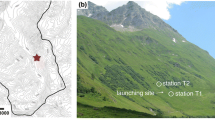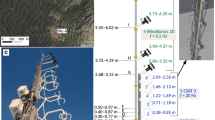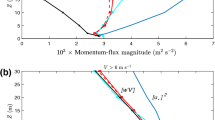Abstract
Slope flow mechanisms are crucial for the transport of air pollutants in complex terrain. Previous observations in sloping terrain showed upslope flows filling the entire convective boundary layer (CBL) and reducing air pollution concentrations by venting air pollutants out of the CBL into the free atmosphere. During the Pacific 2001 Air Quality Field Study in the Lower Fraser Valley, British Columbia, Canada, we observed slope flows during weak synoptic winds, clear skies, and strong daytime solar heating. With a Doppler sodar we measured the three wind components at the foot of a slope having an average angle of 19° and a ridge height of 780 m. We operated a scanning lidar system and a tethersonde at a nearby site on the adjacent plain to measure backscatter of particulate matter, temperature, wind speed, wind direction, and specific humidity. Strong daytime upslope flows of up to 6 m s−1 through a depth of up to 500 m occurred in the lower CBL, but with often equally strong and deep return flows in the upper part of the CBL. The mass transport of upslope flow and return flow approximately balanced over a 4-h morning period, suggesting a closed slope-flow circulation within the CBL. These observations showed that air pollutants can remain trapped within a CBL rather than being vented from the CBL into the free atmosphere.
Similar content being viewed by others
References
B.W. Atkinson (1981) Meso-scale Atmospheric Circulations Academic Press London 495
R.M. Banta (1984) ArticleTitleDaytime Boundary-Layer Evolution over Mountainous Terrain. Part I: Observations of the Dry Circulations Mon. Wea. Rev 112 340–356
M. Brehm (1986) Experimentelle und numerische Untersuchungen der Hangwindschicht und ihre Rolle bei der Erwärmung von Tälern. Ph.D. Dissertation Ludwig-Maximilians-Universität München Germany 173
R.-R. Chen N.S. Berman D.L. Boyer H.J.S. Fernando (1996) ArticleTitlePhysical Model of Diurnal Heating in the Vicinity of a Two-dimensional Ridge J. Atmos. Sci 53 62–85
B. Davidson (1963) ArticleTitleSome Turbulence and Wind Variability Observations in the Lee of Mountain Ridges J. Appl. Meteorol 2 463–472
J.W. Deardorff G.E. Willis (1987) ArticleTitleTurbulence within a Baroclinic Laboratory Mixed Layer above a Sloping Surface J. Atmos. Sci 44 772–778
Defant, F. (1949). Zur Theorie der Hangwinde, nebst Bemerkungen zur Theorie der Berg- und Talwinde. Arch. Met. Geoph. Biokl., Ser. A 1: 421–450. English in: Whiteman, C. D. and Dreiseitl, E. (1984). Alpine Meteorology. Translations of Classic Contributions by A. Wagner, E. Ekhart and F. Defant. Pacific Northwest Laboratory, Richland, Washington, pp. 95-121
S. Wekker Particlede (1997) The Behaviour of the Convective Boundary Layer Height over Orographically Complex Terrain. Master Thesis, Universität Karlsruhe Germany and Wageningen Agricultural University The Netherlands 295
S. Wekker Particlede (2003) Structure and Morphology of the Convective Boundary Layer in Mountainous Terrain. Ph.D. Dissertation The University of British Columbia Canada 191
J. Egger (1981) ArticleTitleOn the Linear Two-dimensional Theory of Thermally Induced Slope Winds Beitr. Phys. freien Atmos 54 465–481
T. Haiden (1990) Analytische Untersuchungen zur konvektiven Grenzschicht im Gebirge. Ph.D. Dissertation Universität Wien Austria 140
L.K. Ingel’ (2000) ArticleTitleNonlinear Theory of Slope Flows Izvestiya Atmos. Ocean. Phys 36 384–389
H. Kondo (1984) ArticleTitleThe Difference of the Slope Wind Between Day and Night J. Meteorol. Soc. Japan 62 224–232
M. Koßmann (1998) Einfluß orographisch induzierter Transportprozesse auf die Struktur der atmosphärischen Grenzschicht und die Verteilung von Spurengasen. Ph.D. Dissertation Fakultät für Physik der Universität Karlsruhe (TH) Karlsruhe 193
T. Kuwagata J. Kondo (1989) ArticleTitleObservations and Modeling of Thermally Induced Upslope Flow Boundary-Layer Meteorol 49 265–293
S.-M. Li (2004) ArticleTitleA Concerted Effort to Understand the Ambient Particulate Matter in the Lower Fraser Valley: The Pacific 2001 Air Quality Study Atmos. Environ 38 5719–5731 Occurrence Handle1:CAS:528:DC%2BD2cXnvVeqs7g%3D
B. Mendonca (1969) ArticleTitleLocal Wind Circulation on the Slopes of Mauna Loa J. Appl. Meteorol 8 533–541
S. Mitsumoto (1989) ArticleTitleA Laboratory Experiment on the Slope Wind J. Meteorol. Soc. Japan 67 565–574
W.D. Neff (1990) Remote Sensing of Atmospheric Processes over Complex Terrain W. Blumen (Eds) Atmospheric Processes Over Complex Terrain. Meteorological Monographs 23(45) American Meteorological Society Boston 173–228
H.D. Orville (1964) ArticleTitleOn Mountain Upslope Winds J. Atmos. Sci 21 622–633
Z. Petkovšek (1982) ArticleTitleEin einfaches Modell des Tages-Hangwindes Zeits. Meteorol 32 31–41
L. Prandtl (1942) Führer durch die Ströhmungslehre. Vieweg, Braunschweig English: Essentials of Fluid Dynamics. Blackie London 452
C. Reuten D.G. Steyn K.B. Strawbridge P. Bovis (2002) ArticleTitleAir Pollutants Trapped in Slope Flow Systems Bull. Amer. Meteorol. Soc 83 966
U. Schumann (1990) ArticleTitleLarge-eddy Simulation of the Upslope Boundary Layer Quart. J. Roy. Meteorol. Soc 116 637–670
M. Segal Y. Ookouchi R.A. Pielke (1987) ArticleTitleOn the Effect of Steep Slope Orientation on the Intensity of Daytime Upslope Flow J. Atmos. Sci 44 3587–3592
D.G. Steyn D.A. Faulkner (1986) ArticleTitleThe Climatology of Sea-Breezes in the Lower Fraser Valley, BC Climatol. Bull 20 21–39
D.G. Steyn J.W. Bottenheim R.B. Thompson (1997) ArticleTitleOverview of Tropospheric Ozone in the Lower Fraser Valley, and the Pacific ’93 Field Study Atmos. Environ 31 2025–2035 Occurrence Handle1:CAS:528:DyaK2sXjsl2mt74%3D
K.B. Strawbridge B.J. Snyder (2004) ArticleTitlePlanetary Boundary Layer Height Determination during Pacific 2001 Using the Advantage of a Scanning Lidar Instrument Atmos. Environ 38 5861–5871 Occurrence Handle1:CAS:528:DC%2BD2cXnvVeqsLk%3D
I. Vergeiner (1982) ArticleTitleEine energetische Theorie der Hangwinde. 17. Int. Tag. Alpine Meteorol.. Berchtesgaden, 1982 Ann. Meteorol 19 189–191
I. Vergeiner (1991) ArticleTitleComments on ‘Large-Eddy Simulation of the Up-Slope Boundary Layer’ by Ulrich Schumann (April 1990, 116, 637-670) Quart. J. Roy. Meteorol. Soc 117 1371–1372
B. Vogel G. Adrian F. Fiedler (1987) MESOKLIP – Analysen der Meteorologischen Beobachtungen von Mesoskaligen Phänomenen im Oberrheingraben Inst. für Meteorologie Klimaforschung der Univ. Karlsruhe Germany 369
R. Wenger (1923) ArticleTitleZur Theorie der Berg- und Talwinde Meteorol. Zeits 40 193–204
C.D. Whiteman (2000) Mountain Meteorology Fundamentals and Applications. Oxford University Press New York 355
G.L. Wooldridge E.L. McIntyre SuffixII (1986) ArticleTitleThe Dynamics of the Planetary Boundary Layer over a Heated Mountain Slope Geofizika 3 3–21
Z.J. Ye M. Segal R.A. Pielke (1987) ArticleTitleEffects of Atmospheric Thermal Stability and Slope Steepness on the Development of Daytime Thermally Induced Upslope Flow J. Atmos. Sci 44 3341–3354
Author information
Authors and Affiliations
Corresponding author
Rights and permissions
About this article
Cite this article
Reuten, C., Steyn, D.G., Strawbridge, K.B. et al. Observations of the Relation Between Upslope Flows and the Convective Boundary Layer in Steep Terrain. Boundary-Layer Meteorol 116, 37–61 (2005). https://doi.org/10.1007/s10546-004-7299-7
Received:
Issue Date:
DOI: https://doi.org/10.1007/s10546-004-7299-7




